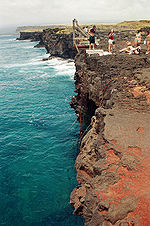Ka Lae
South Point Complex | |
Nā'ālehu | |
| Coordinates | 18°54′40″N 155°40′52″W / 18.9111°N 155.681111°W |
|---|---|
| Area | 710 acres (290 ha) |
| NRHP reference No. | 66000291[1] |
| Significant dates | |
| Added to NRHP | October 15, 1966[1] |
| Designated NHLD | December 29, 1962[2] |


Ka Lae (
Geography
The name for the southern tip of the island of Hawaiʻi comes from Ka Lae in the Hawaiian language which means "the point".[3] It is often spelled as one word, Kalae, or called South Point or South Cape.[4] A confluence of
The confluence of currents also means the area is prone to accumulation of
Ka Lae is accessible via South Point Road, a 12-mile paved narrow road leading from
Ka Lae is
History
South Point archaeological site
Ka Lae is the site of one of the earliest Hawaiian settlements, and it has one of the longest archaeological records on the islands.[2] It is generally thought that this is where the Polynesians first landed because the Big Island is the closest of the Hawaiian Islands to Tahiti, and Ka Lae would be the point of first landfall.[7] Ruins of an ancient Hawaiian temple (heiau) and a fishing shrine can be found here. In addition, ancient Hawaiians drilled numerous holes in the rock ledges to use for mooring their canoes. Tying long ropes to their boats, they would drift out to sea to fish without fear of being carried away by the strong currents.[8] Anthropologists from the Bishop Museum excavated the area in the 1960s.[9][10][11]
Ka Lae Light
On March 5, 1906, a small lighthouse opened at the point. In 1908 about 10 acres (4.0 ha) were set aside for the United States Coast Guard to build a house for a keeper. At the request of William Tufts Brigham of the Bishop Museum, care was taken not to destroy the archaeological site. In 1929 a steel tower was built for the light, and in 1972 a new 32 foot (10m) concrete tower with solar power was built.[12][13]
A
Recent history



During
A space tracking station was operated from 1964 to 1965, and in the 21st century the Swedish Space Corporation's Universal Space Network again established a remote ground station for space tracking and communications, now consisting of two 13-meter parabolic antennas on the east side of South Point Road.[20] Also at Ka Lae are the large shortwave radio antennas of World Harvest Radio International, which used callsign KWHR until 2009.[21]
In 1987 the Kamaoa Wind Farm began operation with thirty-seven Mitsubishi 250
Southernmost point
Ka Lae Point is the southernmost point of all fifty states in the
See also
- Great Pacific Garbage Patch
References
- ^ a b "National Register Information System". National Register of Historic Places. National Park Service. July 9, 2010.
- ^ a b "South Point Complex". National Historic Landmark summary listing. National Park Service. Archived from the original on May 11, 2011. Retrieved July 4, 2008.
- University of Hawaii Press. Retrieved September 20, 2010.
- ^ U.S. Geological Survey Geographic Names Information System: Kalae
- ^ "Kaʻu". Coffee Times.
- ^ "Marine Debris Removal from the Waiohinu-Ka Lae Coast Hawaii Island". Marine Debris Program. NOAA. September 18, 2006.
- ^ "Ka Lae, Ka'u, Kailua-Kona". Kailua-Kona Travel Guide. Virtual Tourist. October 5, 2002.
- ISBN 0-86442-489-2.
- OCLC 659366796.
- OCLC 659366796.
- OCLC 659366796.
- ^ "Minor light of Hawai'i - Ka Lae, HI". Lighthouse Friends web site. Retrieved April 15, 2010.
- ISBN 978-0-8248-1319-2.
- ^ "NOAA Weather Radio WWG27". National Oceanic and Atmospheric Administration. Retrieved April 15, 2010.
- ^ "South Point, Hawaii ARC Wind Sensor". National Weather Service. Retrieved April 15, 2010.
- ^ Pauk Freeman (January 1, 2010). "Morse Field, South Point, HI". Abandoned & Little-Known Airfields: Hawaii, Hawaii island. Retrieved April 15, 2010.
- ^ Cliff Lethbridge (2000). "Space Program Has A Space Problem And A New Spaceport Is Born". History of Cape Canaveral. Archived from the original on August 29, 2012. Retrieved April 15, 2010.
- ^ "South Cape (Morse Field) Airport". Hawaii Aviation Archive. State of Hawaii Department of Transportation, Airports Division. Retrieved April 15, 2010.
- ^ Jonathan Eberhart (March 26, 1988). "Hawaii: A Stepping Stone to Space?". Science news.
- ^ "Universal Space Network Expands Satellite Ground Stations". SSC Group. September 19, 2007. Archived from the original on January 1, 2014. Retrieved March 29, 2014.
- ^ "Station Record - KWHR". Federal Communications Commission. Retrieved April 15, 2010.
- ^ "History of Wind Energy Projects in Hawaii". State of Hawaii Department of Business, Economic Development & Tourism web site. April 15, 2002. Archived from the original on July 24, 2008. Retrieved April 15, 2010.
- ^ Associated Press (July 20, 2007). "Big Isle wind farm boosts grid". Honolulu Star-Bulletin. Retrieved April 15, 2010.
- ^ Tawhiri Power, LLC
- ^ "Pakini Nui Find Farm". Tawhiri Power LLC web site. Retrieved April 15, 2010.
- ^ "GAO/OGC-98-5 – U.S. Insular Areas: Application of the U.S. Constitution". U.S. Government Printing Office. November 7, 1997. Retrieved March 18, 2018.
External links
- "South Point Hawaii". community web site. 2004. Retrieved April 15, 2010.
- Pictures of Ka Lae
- "U.S. Wind Energy Projects - Hawaii". [American Wind Energy Association web site]. Washington, DC, USA: American Wind Energy Association. December 31, 2009. Archived from the original on September 18, 2010. Retrieved April 15, 2010.
